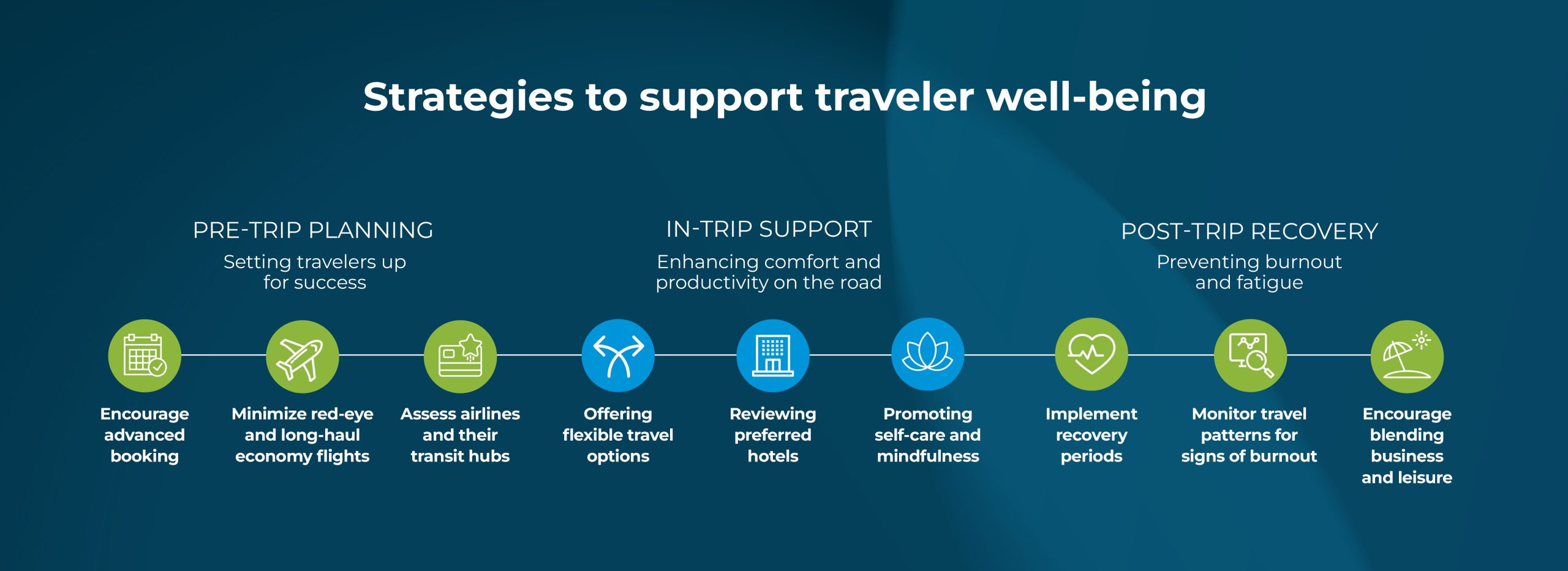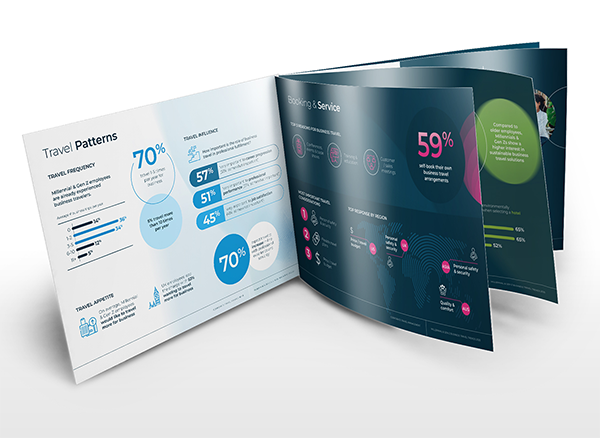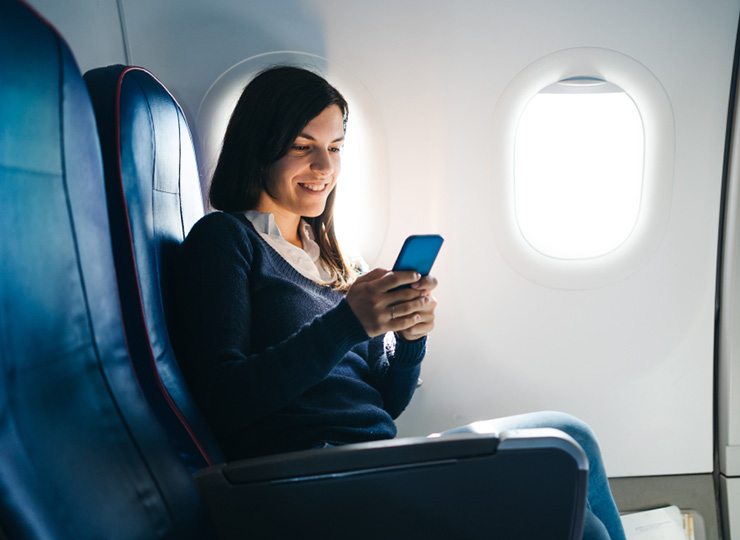

How to create a corporate traveler well-being strategy
To create a corporate traveler well-being strategy, organizations need to design travel programs that actively enhance well-being rather than contribute to stress and fatigue. Corporate travel isn’t just about cost savings and logistics; it’s about people. A well-supported traveler is a productive, engaged and loyal employee.
An Airport Service Quality (ASQ) Report found that travelers want to reduce stress and anxiety, with 33% highlighting a demand for wellness-focused environments to improve their travel experience. A holistic well-being strategy considers the full traveler journey, from pre-trip preparation through to returning home.
Travel program managers should also collaborate with stakeholders such as HR, risk management and sustainability teams. These groups can integrate initiatives like mental health support, physical wellness programs, and work-life balance policies, helping organizations foster an environment where employees feel cared for, leading to higher productivity, satisfaction and loyalty.
In this blog, you’ll discover insights and strategies to build a traveler well-being program that reduces stress and maximizes productivity.
Create travel itineraries that prioritize comfort and health
Corporate travel can often be physically demanding. Long flights, tight schedules and unfamiliar environments can strain a traveler’s physical health, leading to fatigue, jetlag and discomfort. A holistic well-being strategy addresses these challenges by ensuring the travel program supports physical comfort.
The ASQ 2024 Report found a growing demand for premium services, including faster check-ins and enhanced lounge experiences, with personalized, engaging and entertaining journeys. Choosing the right airline and hotel partners isn’t just about cost; it’s about ensuring travelers arrive well-rested and ready to perform.

Minimize travel stress and maximize productivity
The mental and emotional health of corporate travelers can be overlooked, but it’s just as critical. Frequent travel can be isolating and may impact personal well-being and professional performance. On the flip side, short-term business travel may have a positive impact, providing a change of environment and exposure to new destinations, experiences and people; so, finding balance for travelers while achieving organizational goals is important.
To support mental well-being, organizations can focus on reducing stressors tied to travel that may lead to burnout. This might be frequent overnight trips, time-zone changes, last-minute and weekend travel.
Access to these data insights can provide travel program managers with early detection of travel patterns that may lead to fatigue and allow employees to stay in control and reduce stress.
Additionally, organizations can encourage mindfulness practices, ensuring travelers have enough downtime to unwind and participate in activities they enjoy, such as reading a book, taking a walk, enjoying the local surroundings and fostering communication that allows employees to express concerns about their trips.

How to help travelers maintain work-life balance on the road
The emotional impact of travel is also worth addressing. For many travelers, extended trips can blur the boundaries between work and personal life, creating a sense of disconnection from family and home life. A corporate traveler well-being strategy helps travelers maintain a balance and feel emotionally supported throughout their journey.
One effective approach is to provide resources that allow for work-life balance on the road, such as flexible working hours, opportunities for downtime, or even tools that encourage connection with loved ones. Encouraging travel policies that allow travelers to extend work trips into personal vacations (where possible) may further enhance emotional well-being.
Using technology to create smarter, well-being focused travel programs
Technology will play an increasingly pivotal role in shaping well-being strategies.
Access to information such as:
- the number of trips taken
- how many time zones have been crossed
- last-minute bookings
- long-haul economy usage
- red-eye flights
- the hours of travelling in personal time
can all contribute to traveler fatigue and stress levels, depending on the frequency. By taking a proactive approach, organizations can help reduce the emotional toll that extended travel or high-pressure schedules may have on their employees.

For instance, the well-being score gives travel managers insight into travelers’ estimated well-being by analyzing their travel patterns. It calculates a score based on their trips over the past 90 days and forecasts their well-being for the next 14 days.
Well-being data then provides valuable insight that can help companies gauge the overall health of their corporate travel program and understand traveler experiences on a deeper level. By analyzing factors like sleep patterns, travel stress, and trip fatigue, companies can make informed decisions about how to improve the travel experience and better support their employees.
Strategies to support traveler well-being
A well-structured travel program goes beyond booking flights and hotels, it actively supports employee well-being at every stage of the journey. Here’s how travel managers can make a real impact:
1. Pre-trip planning: setting travelers up for success
Making strategic decisions before a trip even begins can significantly reduce stress and fatigue. Organizations can:
- Encourage advanced booking: Reducing last-minute trips gives travelers more control over their schedules and allows for better planning of flights, accommodations and meetings.
- Minimize red-eye and long-haul economy flights: When possible, prioritize flights at reasonable times and offer premium economy or business class for frequent long-haul travelers.
- Assess airlines and their transit hubs: Partnering with reputable airlines that offer a high standard of product and service complemented by state-of-the-art airports with shorter connection times and wellness amenities (lounges, rest areas, etc.) improves the travel experience.
2. In-trip support: enhancing comfort and productivity on the road
Travelers face various stressors while in transit and at their destination. Organizations can help by:
- Offering flexible travel options: Allowing employees to arrive a day early before critical meetings gives them time to acclimatize and rest.
- Reviewing preferred hotels: Ensuring accommodation meets comfort and wellness standards (e.g., nutritious meals, high-quality bedding, fitness facilities) supports better rest and recovery.
- Promoting self-care and mindfulness: Encouraging small habits like taking walks, enjoying the local surroundings, or disconnecting after work hours can help maintain mental and physical health.
3. Post-trip recovery: preventing burnout and fatigue
Returning from a trip should not immediately mean jumping back into high-pressure work. Organizations may:
- Implement recovery periods: Set internal guidelines on mandatory rest time after long-haul or overnight travel to help employees feel energized and motivated.
- Monitor travel patterns for signs of burnout: By using well-being data, HR and travel teams can identify employees at risk and adjust their schedules accordingly.
- Encourage blending business and leisure (where possible) – allowing employees to extend a work trip for personal time can reduce stress and improve overall job satisfaction.

Travel program managers have a unique opportunity to shape a culture of care. By leveraging tools like CTM’s well-being scores and implementing proactive strategies, organizations can make positive change in the fabric of their travel programs and create a culture of care that prioritizes the health and well-being of their travelling workforce. This can result in a positive travel experience for everyone, no matter where their business travel takes them.
How will you put corporate traveler well-being first?
CTM is ready to support your business and keep your people and business moving.




